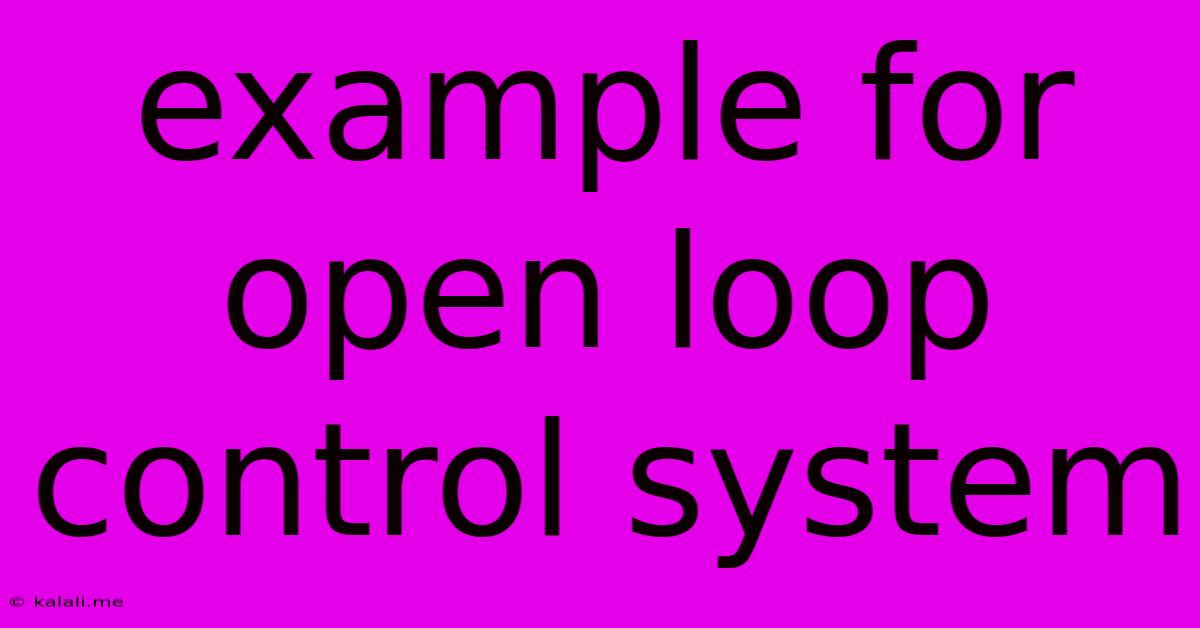Example For Open Loop Control System
Kalali
Jun 14, 2025 · 3 min read

Table of Contents
Understanding Open Loop Control Systems: Real-World Examples
Open-loop control systems, also known as non-feedback control systems, operate without any feedback mechanism to compare the actual output to the desired output. They simply execute a pre-programmed sequence of actions based on the input. This contrasts with closed-loop systems, which constantly monitor and adjust their output based on feedback. While simpler to design and implement, open-loop systems are less accurate and susceptible to disturbances. Let's explore some everyday examples to solidify your understanding.
What defines an open-loop system? The key characteristic is the absence of a feedback mechanism. The controller doesn't know whether the system is performing as intended; it simply follows its programmed instructions. This often results in less precise control and potential for errors if external factors affect the system's operation.
Real-World Examples of Open-Loop Control Systems:
Here are some clear examples illustrating the concept:
1. Washing Machine Timer:
A simple washing machine timer is a classic example. You set the wash cycle (e.g., 30 minutes), and the machine follows a pre-determined sequence of actions – filling with water, agitation, rinsing, and spinning – for the specified duration. There's no sensor measuring the cleanliness of the clothes or the water temperature; it simply completes the cycle based on the timer. External factors, such as the initial water temperature or the amount of laundry, can affect the outcome, but the system remains oblivious.
2. Traffic Light System (Simplified):
A basic traffic light system operates on a predetermined timer sequence, cycling through green, yellow, and red lights. There's no feedback mechanism that adjusts the timing based on the actual traffic flow. It's a simple open-loop system – predictable but not necessarily efficient in adapting to varying traffic conditions. More sophisticated systems do incorporate feedback mechanisms, making them closed-loop.
3. Microwave Oven:
When you set the cooking time on a microwave, it operates as an open-loop system. The oven runs for the specified duration, regardless of whether the food is cooked perfectly. It doesn’t monitor the internal temperature or the food's readiness; it simply heats for the set time. This simplicity makes it inexpensive and user-friendly, but also means you need to manually adjust the cooking time based on your experience.
4. Cruise Control (Simplified):
While modern cruise control uses closed-loop feedback for maintaining speed, a simplified version without speed sensors could be considered open-loop. Imagine a system that simply maintains a constant throttle position based on a driver's initial input. Any changes in incline or wind resistance would directly affect the vehicle's speed, without the system making any adjustments.
5. A Simple Sprinkler System:
A basic sprinkler system that runs for a pre-determined time, regardless of soil moisture, is another open-loop example. It doesn't monitor the moisture level and adjust its operation accordingly; it simply waters for a set period. This approach can be inefficient, leading to water waste in dry conditions or overwatering in wet ones.
Limitations of Open-Loop Control Systems:
- Sensitivity to Disturbances: External factors can significantly impact the system's performance without any corrective action.
- Lack of Accuracy: The output might deviate significantly from the desired value.
- Inability to Adapt: Open-loop systems are inflexible and can't adjust to changing conditions.
When are Open-Loop Systems Suitable?
Despite their limitations, open-loop systems are suitable for certain applications where simplicity and cost-effectiveness are prioritized over precision. They are often employed in applications where:
- Precise control isn't critical.
- The environment is relatively stable and predictable.
- The system is inexpensive and simple to design.
Understanding the fundamental differences between open and closed-loop control systems is crucial for anyone working in automation, robotics, or any field involving control systems. This knowledge allows engineers to select the most appropriate control strategy for a given application, balancing performance, cost, and complexity.
Latest Posts
Latest Posts
-
Whats The Square Root Of 288
Jun 15, 2025
-
Population Of Scheduled Caste In India
Jun 15, 2025
-
Which Of The Following Materials Is Considered A Conductor
Jun 15, 2025
-
How Do The Bhaktis And Sufis Compare
Jun 15, 2025
-
Which Of The Following Statements About Computer Networks Is True
Jun 15, 2025
Related Post
Thank you for visiting our website which covers about Example For Open Loop Control System . We hope the information provided has been useful to you. Feel free to contact us if you have any questions or need further assistance. See you next time and don't miss to bookmark.